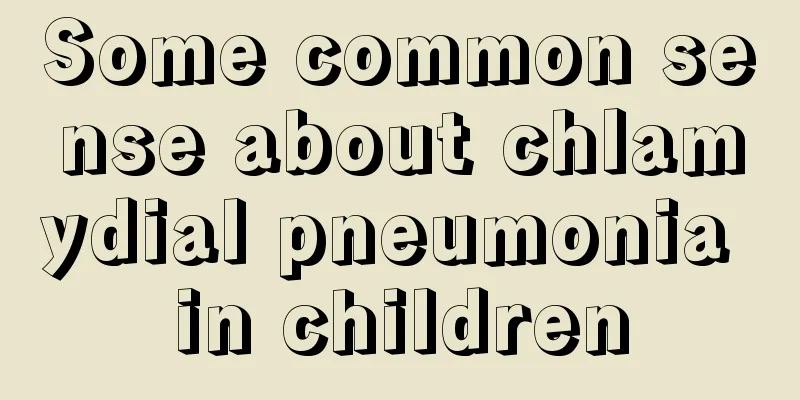Some common sense about chlamydial pneumonia in children

|
Children's physical health is the most concerned issue for parents, but we should also know that since children's organs are not yet fully developed, their resistance and immunity are not as strong as those of adults. Children are prone to various diseases, so parents must help children prevent diseases. Below we will introduce to you some common knowledge about chlamydial pneumonia in children. Chlamydial pneumonia in children is an acute lung inflammation caused by Chlamydia pneumoniae. Chlamydia trachomatis pneumonia mainly occurs in newborns and young infants and is directly transmitted from infected mothers; Chlamydia psittaci pneumonia is a lung infection in humans that occurs through contact with infected birds or inhalation of dust contaminated by their secretions and feces. Chlamydial pneumonia in children can be sporadic or epidemic. The incubation period is 6 to 14 days. Chlamydia trachomatis pneumonia mainly occurs in newborns and young infants and is directly transmitted from infected mothers; Chlamydia psittaci pneumonia is a lung infection in humans that occurs through contact with infected birds or inhalation of dust contaminated by their secretions and feces. Chlamydia pneumoniae enters the human body through the respiratory tract, multiplies in monocytes and releases toxins, which spread through the bloodstream to the lungs and systemic tissues. 1. Chlamydia trachomatis pneumonia Symptoms usually appear 2 to 12 weeks after birth, with a slow onset, usually without fever or occasional low fever, mild respiratory symptoms, followed by cough and shortness of breath, often with fine moist rales or crackles during inhalation, and a few have expiratory wheezing. About 50% of children also suffer from conjunctivitis or have a history of conjunctivitis. 2. Chlamydia psittaci pneumonia The incubation period is 6 to 14 days. The disease presents with cold-like symptoms, often with fever. The cough is dry at the beginning, followed by sputum, and the breathing difficulty may be mild or severe. There are relatively slow pulse, myalgia, chest pain, loss of appetite, and occasionally nausea and vomiting. If it is a systemic infection, there may be symptoms of central nervous system infection or myocarditis, jaundice may be seen occasionally, and liver and spleen enlargement may be common. 3. Chlamydia pneumoniae pneumonia The clinical manifestations are nonspecific and similar to those of mycoplasma pneumonia. The disease has a slow onset, a long course, and generally mild symptoms, often accompanied by pharyngitis, laryngitis, and sinusitis. After the symptoms of upper respiratory tract infection subside, symptoms of bronchitis and pneumonia such as dry and wet rales appear. Cough symptoms may last for more than 3 weeks. In the above article, we introduced the reasons why children are prone to illness. Since children’s body resistance and immunity are not very strong, they are easily invaded by diseases. The above article introduces in detail some common knowledge about chlamydial pneumonia in children. I believe that the information introduced above is useful to everyone. |
<<: Dietary taboos for children with pneumonia
>>: Precautions for 4-year-old baby cough
Recommend
Symptoms and treatment of tongue coating in children
Childhood is originally a lively and happy age. H...
What to do if your child sleeps with his mouth open
Many parents will find that their babies always o...
Unexplained recurrent fever in children
Children have weak constitutions and their body f...
What to do if your five-month-old baby refuses to drink a bottle
Some people say that if the first milk a baby eat...
Six-year-old child has blood in stool but no pain
If a six-year-old child has blood in his stool wi...
What is the reason for a newborn baby to have active bowel sounds and fart?
Farting is a very common phenomenon in life. Both...
What to do if your child has otitis media
Children are a high-risk group for otitis media, ...
What to do if your 8-year-old child is disobedient
As the saying goes, a child's future can be s...
Why do children sweat?
Adults always sweat when the weather is hot. But ...
Sleep time and precautions for seven-month-old babies
A seven-month-old baby is in a critical stage of ...
What to do if your baby has a cold and coughs at night
Many mothers have reported that their babies coug...
What should I do if my baby has a cold and a stuffy nose?
Cold is the most common disease, especially durin...
How to treat small red pimples on children’s faces?
Recently, I have seen many mothers asking online ...
What to do if children have tongue tip ulcers
Many children will suffer from tongue tip ulcers....
The reason why babies are born with yellow hair
There are many parents who, if they find that the...









